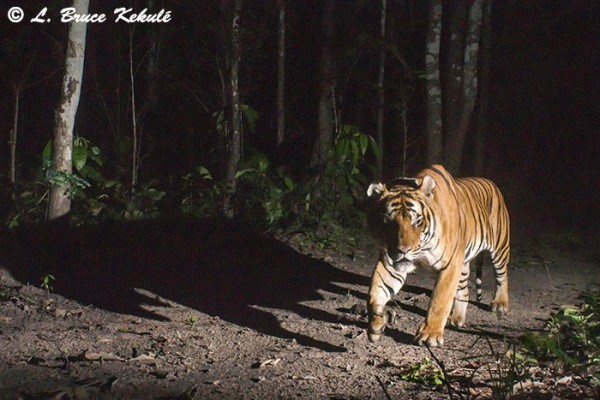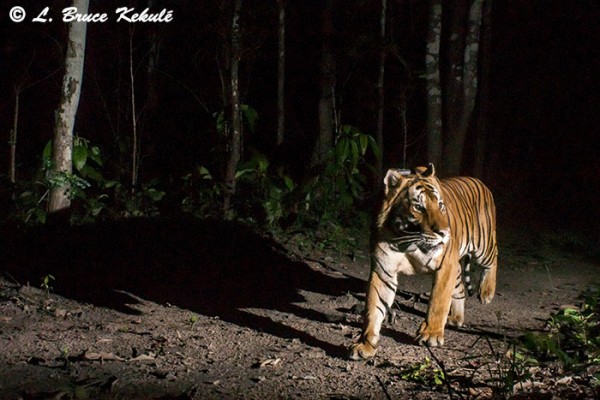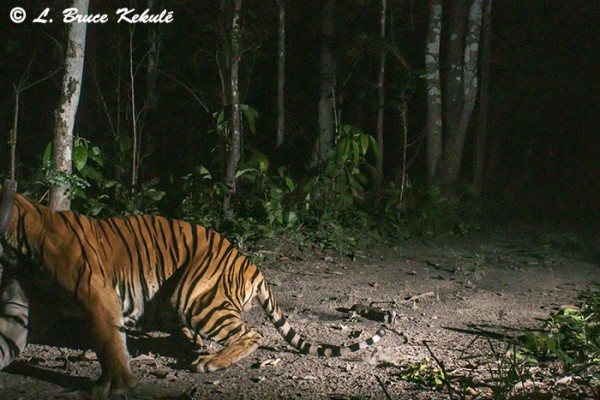Archive for October, 2014
Nikon D90 catches a rare ‘clouded leopard’…!
One of the most beautiful of all the Asian wild cats
Once upon a time, the clouded leopard (Neofelis nebulosa) was found all over Thailand when some 75 percent of the country was covered in forest. At the end of WWII, the human population really began to explode and these magnificent biospheres were cut down for agriculture and settlement taking all the natural resources in its wake. Modern transportation, weapons and logging on a grand scale began to quickly shrink this once remarkable heritage.
Barely 20 percent forest cover is now surviving in an ever-shrinking wilderness. The clouded leopard has been exterminated primarily for its pelt and now survives in all but a few protected areas throughout the Kingdom. It is one of the most beautiful marked creatures in the world. The marbled cat (Pardofelis marmorata), another wild feline is similar in coat pattern but smaller in size. Both of these cats have become extremely rare throughout their range.
In July of this year, I decided to make a trip down to Khlong Saeng Wildlife Sanctuary in southern Thailand in conjunction with Greg McCann and Habitat I.D. (NGO to monitor wildlife in Southeast Asia) to set some camera traps in the moist evergreen forest to see what was still thriving here. Three years ago, I did a camera trap and photographic survey of this protected area and got a marbled cat up on a ridgeline in the interior, plus a clouded leopard in a cave entrance at another location. I knew there was still good possibilities that I would get these cats again.
I decided to set my Nikon D90 DSLR trail cam along with a couple Bushnell Trophy Cams at this same location. Unfortunately, the hard-wired slave flashes were not working due to wiring problems and so left the cam with its single hot-shoe mounted Nikon SB-400 flash. I knew then if the cam caught any creature, I would get images with ‘eye-shine’ but decided to leave it anyway.
I have just returned from Khlong Saeng to collect the data from these cams. Imagine my surprise to see a clouded leopard on the D90’s card. It was an absolute joy to see this cat had passed the cam and even though the ‘eye-shine’ was there, the markings and beauty of this carnivore is truly remarkable. I have pulled the D90 and put a Canon 400D with three Nikon SB-28 slaves which was working very well when I left it. The Bushnell cams also recorded many other species and I will be doing a video post soon. Enjoy…!
Indochinese tiger male caught on video and DSLR
A video and still photos of an Indochinese tiger in the Western Forest Complex of Thailand. This male cat was camera trapped in the afternoon and then in mid-morning…a beautiful carnivore.
The message is the same: these magnificent cats need 100% increase in protection and enforcement as they have become extremely rare in the wild. Unfortunately, some bad people chase after them for bones to be sold on the black market…! The main worry is that help will come too little and too late to really save the tiger and other creatures of the Thai forest…! Enjoy the beauty of raw nature but never forget this message: We need to work hard to change things so these magnificent cats will continue to roam the forest…!
Canon 600D catches a big male tiger
A lucky catch in late afternoon…!
I was finally able to set my Canon 600D with two Nikon SB-28 flashes on a trail where I previously set my BFOutdoors P41 and captured tiger, yellow and black phase leopards plus many other creatures found in this forest. It has been a great location and the set has been very productive.
However, the sensor was not working properly (old #5 with refresh) and run the batteries down. I recently got the #5 program without refresh (many thanks to Johnnydeerhunter on Camtrapper.com) and installed the new chip. It worked like a charm and the Canon will fire off 6 shots a second and wake-up the flashes. The cam and flashes were working great when I left it. I also set up a DXG 567 ‘blackflash’ homebrew video cam close to the Canon to record any animals that passed by (I’ll be posting a video of this cat passing the cam twice).
It has been extremely wet and for some odd reason, the flashes stopped working but the camera continued to crank along. I was pleasantly surprised when I visited the location a couple days ago. On the card was a male tiger that walked past the cam at 4:40PM on October 4th but the flashes did not trigger which created some undesirable noise in this image. This shot is the best of the lot with some highlights on his family jewels and legs, plus a superb back-lit forest. Needless to say, I was still happy with the results and will put this Canon back ASAP…the location certainly has potential and my hope for that black leopard continues…one of these days….Enjoy…!
Sony A500 catches a male tiger with a ‘radio collar’
A male Indochinese tiger in the Western Forest Complex of Thailand..!
What are the odds that my DSLRs would capture two different tigers sporting radio collars within one week of each other..? These are real fluke camera trap shots taken some twenty kilometers away from my Nikon D700 that caught a female also with a collar at the ‘tiger log’. I just posted this on this website a couple of days ago. http://brucekekule.com/camera_trapping/nikon-d700-catches-an-indochinese-female-tiger-sporting-a-radio-collar/
The Sony A500 was triggered by a male tiger on Sept. 17, 2014 at 10:26 PM while the D700 got a female on Sept. 24 at 5:45 AM. I only captured two tigers this trip and it seems weird that they both have collars. Maybe the ‘spirits of the forest’ wanted me to really show and tell the world what is actually going on in this forest concerning tigers. Who knows..?
Needless to say, I’ve already vented my feelings about tigers and radio collars in my recent D700 post so there’s no sense in going there again. However, the A500 got a nice string of shots of this male with a huge collar. I think the battery is on the bottom and transmitter on top. This monstrosity surely looks heavy..!
Unfortunately, only one flash on the right triggered which was a bit of a let-down. The other flash was up high on the tree pointing down at the tiger and would have cancelled that shadow. It was one of those things and there’s always next time. The A500 fired four quick shots and as the big cat jumped forward, triggered another five as he leaped to the right. All in all, I was still pleased with the results and look forward to a ‘black cat’ that I once videoed in broad daylight at this very location.
Noise is also a problem with these images, as I had to do some heavy tweaking in Camera Raw and Photoshop to get them to acceptable levels. If I had been shooting in JPG. format, there would be no chance to bring these back. RAW capture is the only way to revive images when things get dark with not enough light.
I’m not sure if this is inherent to Sony but I think most makes and brands with low light means serious noise although the newer pro-cameras handle noise quite well. The settings are: ƒ8 – 1/80th – 400 ISO…flash set to ¼ power, and lens was a Minolta 28mm (old lens I have had for years). It’s a wonder I got these shots at all..!
Oh well, back to the drawing board on flash standby power. I’m putting together a couple Nikon SB-28 and SB-600 flashes that will work with hard-wire or radio triggers with four Eneloop AAs in the flash and four rechargeable ‘Ultracell ‘D’ cells with 11,000 mAh capacity as externals to add more power for longer soaks. This will all fit in a lockable ‘Tupperware’ type box as shown.
I will try these on the A500 first to see if there is a difference with staying power. I also believe that three or more flashes are the ticket for well-lit shots…I know Steve Winter with N.G. sometimes uses from 4-5 flashes depending on terrain.
It’s a never-ending battle with the DSLRs but I guess that’s what I like about using them: the challenge to get tigers and leopards on digital camera plus all the other cryptic animals in Thailand’s forests…it all becomes worthwhile when I do get a shot or shots…! Enjoy.












